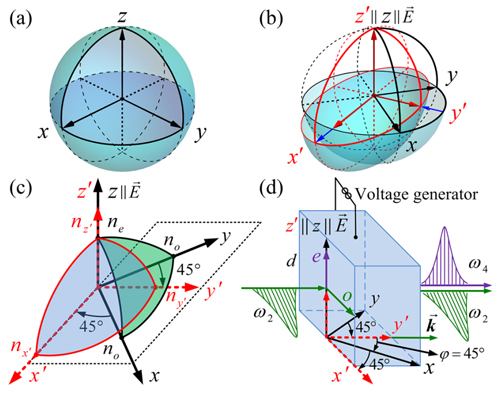Recently, the research group led by Zhu Jianqiang and Liu De'an (Key Laboratory of High Power Laser and Physics, Shanghai Institute of Optics and Fine Mechanics, Chinese Academy of Sciences) made significant progress in the field of nonlinear optical frequency conversion technology. A new class of phase matching methods, termed “voltage tunable phase matching”, is proposed and experimentally verified. The research results were published in the issue of the Physical Review Letters [Phys. Rev. Lett. 118,043901, (2017)]. The first author of the paper is Dr. Cui Zijian. The reviewers spoke highly of the paper "The topic is interesting to a broad community of scientists; the results are new, solid and likely to open interesting perspectives in the field of nonlinear optics."
Nonlinear optical-frequency conversion has greatly expanded the practical utility of lasers and has exhibited significant scientific and technological potential in many fields. For achieving a high conversion efficiency, phase matching between interacting waves is a necessary condition. However, owing to the material dispersion, a phase mismatch (Δk) occurs. Precise compensation of dispersion-caused phase mismatch is the primary challenge, which has been addressed in various ways. Although the angle tuning and quasi phase matching have been proposed by N. Bloembergen et al in 1962, and the temperature tuning phase matching has been demonstrated by Hobden et al in 1966, there are very few practical methods for achieving quasi perfect phase matching.
The method of voltage tuning phase matching can achieve quasi perfect phase matching and obtain the maximum conversion efficiency by introducing the external electric field and using the linear electro-optic effect of the material. It can fundamentally overcome the problems in high power laser system that the conversion efficiency is sensitive to the changes of angle, temperature and wavelength. Meanwhile, the refractive indexes of materials can be controlled flexibly and accurately using this method. The applications of conventional nonlinear materials and even low birefringence and isotropic materials in the field of nonlinear optics can thus be extended.
In order to verify this new method, the researchers designed an ingenious proof-of-principle experiment by applying the linear electro-optic effect and nonlinear optical interaction process simultaneously in a partially deuterated KH2PO4 crystal, and successfully demonstrated the use of the linear electro-optic effects to control the nonlinear interaction between light waves. The validity and feasibility of this method is thus demonstrated. The method of voltage tuning phase matching proposed by this research group not only paves the way for the design of novel nonlinear optical devices but also provides a new direction for the further study of nonlinear optical interactions.

Fig. (a) Refractive-index ellipsoid of a cubic material. Refractive-index ellipsoid variation for (b) a cubic material of space group 4 ̅3m and (c) a DKDP crystal (1/8) with an external electric field along the z-axis. (d) Type-I VTPM fourth-harmonic generation (FHG) achieved in a DKDP crystal.(Image by Cui Zijian) Contact:
Cui Zijian
Shanghai Institute of Optics and Fine Mechanics
E-mail: cuizijian1990@163.com |







